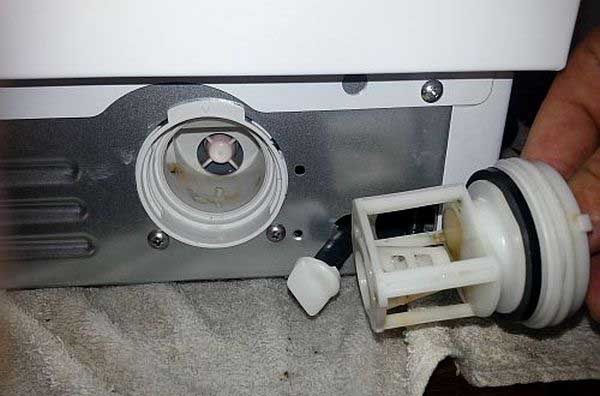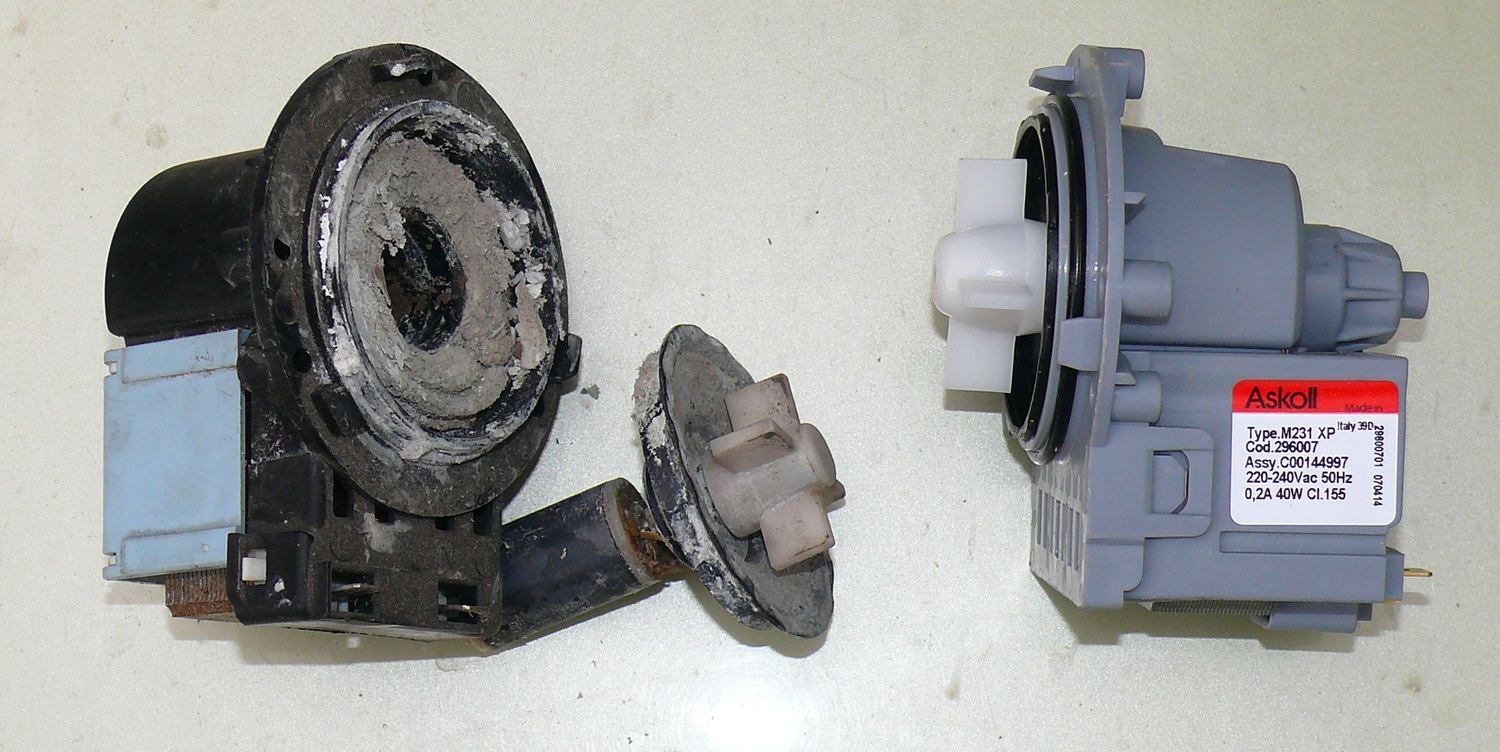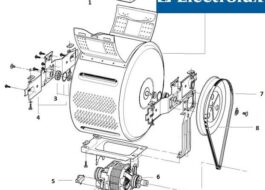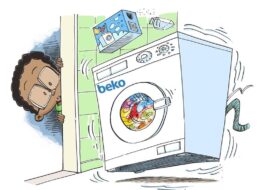Beko washing machine does not drain water
 If the Beko washing machine does not drain the water, then the wash will have to be finished ahead of schedule. A tank full of waste liquid will prevent the machine from spinning the laundry and rinsing it in clean water. Moreover, the washing machine’s safety system will try to “rock” the unit several times, and if it fails, it will display an error and slow down the operation. In any case, you will no longer be able to use the machine. You will have to carry out diagnostics, detect the breakdown and fix it.
If the Beko washing machine does not drain the water, then the wash will have to be finished ahead of schedule. A tank full of waste liquid will prevent the machine from spinning the laundry and rinsing it in clean water. Moreover, the washing machine’s safety system will try to “rock” the unit several times, and if it fails, it will display an error and slow down the operation. In any case, you will no longer be able to use the machine. You will have to carry out diagnostics, detect the breakdown and fix it.
Filter element
To understand what led to the drainage failure, you will have to analyze the behavior of the washing machine. It is important to understand exactly when the system froze, how much water was “pumped out” from the tank, and how noisy the machine was before the incident. Only by diagnosing the equipment can you figure out who is to blame and what to do.
As a rule, problems with drainage on Beko occur in two cases: when the garbage filter is clogged and when there is a problem with the pump. In any case, it is better to start checking with the “trash bin”. We proceed like this:
- de-energize the machine;
- disconnect from the water supply;
- remove all items from the machine that cannot tolerate moisture (powder, rugs);
- We protect the space surrounding the machine from water by covering everything with oilcloth, rags or newspapers;
- prepare a container for collecting water;
- use a flat screwdriver to hook the door of the technical hatch located in the lower right part of the body and remove it;
- we find a garbage filter - a black round lid;
- tilt the washer back until the front legs lift off the floor by 3-8 cm;
- place the container under the filter.

Having prepared, we proceed to removing the filter.The unscrewing process is simple: you need to grab the protruding part of the filter and turn it clockwise. As soon as the spiral loosens, pull it towards you, removing it from its seat. Everything is done as carefully as possible - water under strong pressure will flow out of the tank, splashing.
The removed filter should be carefully inspected and cleaned. First, heavy dirt, adhered debris and tangled hair are removed. Afterwards, the spiral is thoroughly washed under running warm water. If there is scale and other deposits on the surface of the “trash can”, you will have to soak the part. Dilute citric acid in warm water and place a plastic bottle in it for 5-8 hours. Boiling water cannot be used - the material is easily deformed at high temperatures.
Do not remove the garbage filter if there is hot water in the drum - this will cause burns!
Another reason for slow drainage may be a dirty filter seat. Therefore, after unscrewing the “trash can,” it is recommended to shine a flashlight into the vacated hole and pull out all foreign objects from it. It is advisable to “walk” with a wet cloth over the internal surfaces. If after cleaning the problem does not disappear, you will have to go further and inspect the washing machine pump.
Dismantling the pump
Often the pump is to blame for difficult drainage. It is she who must pump out dirty water from the tank, so when it stops, the washing machine cannot empty the drum. To correct the situation, it is necessary to diagnose and repair the pump. But first you have to get it out of the machine.
On Beko washing machines you can get to the pump through the bottom. You need to prepare a wrench, screwdrivers and a container for collecting water, then disconnect the machine from the communications and begin disassembling.We proceed according to the following scheme.
- Use a flat-head screwdriver to pry up the technical hatch and unclip it.
- Unscrew the garbage filter.
- We release the pump from the retaining bolt.
- We unhook all connected wires and pipes.
- Turn the pump counterclockwise while pushing the pump deeper.
- We put our hand through the bottom and pull out the pump.
- Place the part on a dry surface and begin troubleshooting.
Before disassembling, the washing machine must be disconnected from communications!
To make it more convenient to get to the pump with your own hands, you can put Beko on your left side. In this case, you will not have to act by touch, which will speed up the dismantling of the pump. We take out the disconnected pump and begin diagnostics.
Let's take a look and see
Repairing the drain pump means cleaning it. More precisely, you need to clean the pump impeller. To do this, you need to remove the rotating part. This is done simply: use a screwdriver to unscrew all the screws on the body, half the body and find the “head” with the blades.
The impeller should rotate, but not too freely. If the “wheel” flies off the landing axle, then the part must be fixed tighter. When the blades are blocked, we act differently - we clean off all the interfering debris, hair and threads. At the same time, the pump and snail are washed.
The manufacturer recommends comprehensive cleaning of the washing machine at least once a year.
The cleaned parts are returned to their place: the impeller on the pump, and it on the volute. The installation process occurs in reverse order. Upon completion, it is recommended to run a test wash and evaluate the quality of work.If the cycle runs silently, the water successfully drains from the drum into the sewer, and the self-diagnosis system does not detect a failure, then the problem has been resolved. Otherwise you will have to look for a replacement.
Let's test the pump coil
It’s better not to take risks and check the pump for functionality using a multimeter. We take the tester, set it to “Resistance” mode, attach the probes to the pump contacts and note the results on the display. Normally, the device should show a value of 150-260 Ohms.
If “0” is displayed on the screen, then the reason for the pump failure is a short circuit. If the resistance is more than 120 ohms, a winding rupture can be assumed. Repairing a damaged wire is difficult and expensive; it is easier and cheaper to purchase a new pump.
Repairing a pump is difficult and unprofitable - it’s better not to waste time and replace the pump completely!
Replacing a faulty pump at home is easy. The main thing is to purchase a suitable analogue, focusing on the serial number of the existing model Beko. Another option is to dismantle the old device and bring it to the store consultant as a sample.
If cleaning the garbage filter and replacing the pump does not improve the drainage, then the problem is in the control board. It is not recommended to repair the module yourself - it is better to turn to professionals.
Interesting:
1 reader comment
Add a comment Cancel reply
Categories
Washing machine repair


For buyers

For users

Dishwasher

















What if the machine only drains after you blow into the drain hose?